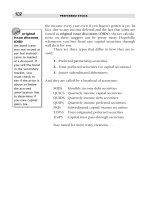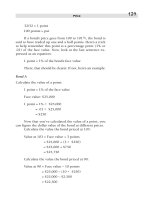Economic analysis in healthcare, 2nd edition
Bạn đang xem bản rút gọn của tài liệu. Xem và tải ngay bản đầy đủ của tài liệu tại đây (7.5 MB, 465 trang )
Contents
Cover
Title Page
Copyright
Dedication
Preface
Chapter 1: Introduction to Economic Analysis in Health Care
1.1 Life, Death and Big Business: Why Health Economics is Important
1.2 Health Care as an Economic Good
1.3 Health and Health Care
1.4 Wants, Demands and Needs
1.5 The Production of Health and Health Care
1.6 Deciding Who Gets What in Health Care
1.7 Is the Market for Health Care Special?
1.8 Describing Versus Evaluating the Use of Health Care Resources
1.9 Judging the Use of Health Care Resources
Summary
Chapter 2: The Demand for Health Care
2.1 Why Study Demand? Profits, Policy and Improving Health
2.2 Consumer Choice Theory
2.3 Demand Functions
2.4 Modelling Choices About Health
2.5 Needs, Wants and Demands
2.6 Asymmetry of Information and Imperfect Agency
2.7 Aggregate Demand for Health Care: Theory and Evidence
Summary
Chapter 3: The Production and Costs of Health Care
3.1 Introduction
3.2 The Theory of Production
3.3 Multi-Product Firms
3.4 Returns to Scale, Additivity and Fixed Factors
3.5 Costs
Summary
Chapter 4: The Supply of Health Care
4.1 Firms, Markets and Industries in the Health Care Sector of the Economy
4.2 Structure, Conduct and Performance in the Health Care Industry
4.3 Profit Maximisation Models
4.4 Goals Other than Profit Maximisation
4.5 Competition, Contestability and Industrial Policy
Summary
Chapter 5: Markets, Market Failure and the Role of Government in
Health Care
5.1 Introduction
5.2 Using Perfectly Competitive Markets To Allocate Resources
5.3 Market Failure In Health Care
5.4 Government Intervention In Health Care
5.5 Government Failure
Summary
Chapter 6: Health Insurance and Health Care Financing
6.1 Uncertainty And Health Care Financing
6.2 Risk And The Demand For Health Insurance
6.3 The Market For Health Insurance And Market Failure
6.4 Reimbursement
6.5 Integration Between Third-Party Payers And Health Care Providers
6.6 Health Care Financing Systems
Summary
Chapter 7: Equity in Health Care
7.1 Introduction
7.2 Equity in the Finance of Health Care
7.3 Equity In Distribution
Summary
Chapter 8: Health Care Labour Markets
8.1 Labour as a Factor of Health Care Production
8.2 Supply of Health Care Labour
8.3 Demand for Health Care Labour
8.4 Wages and Employment in Perfect Labour Markets
8.5 Economic Rent and Transfer Earnings
8.6 Wage Determination and Employment In Imperfect Labour Markets
8.7 Health Care Labour Market Shortages
Summary
Chapter 9: Welfarist and Non-Welfarist Foundations of Economic
Evaluation
9.1 The Normative Economics Foundations of Economic Evaluation
9.2 Welfare Economics
9.3 The Pareto Principle
9.4 Potential Pareto Improvements
9.5 Social Welfare Functions
9.6 Measurability and Comparability of Utility
9.7 The Application of Welfare Economics
9.8 Non-Welfarism
9.9 Is There A Link Between Welfarism and Non-Welfarism?
Summary
Chapter 10: Principles of Economic Evaluation in Health Care
10.1 What Is Economic Evaluation?
10.2 The Economics Foundations of Economic Evaluation
10.3 Economic Evaluation Applied to Health Care Programmes
10.4 Decision Rules for Cost–Benefit Analysis
10.5 Decision Rules for Cost-Effectiveness and Cost-Utility Analysis
10.6 Equity in Economic Evaluation
Summary
Chapter 11: Measuring and Valuing Health Care Output
11.1 Introduction
11.2 Monetary Valuations of Health Care Benefits
11.3 The Measurement of Health Outcomes
11.4 Making Health Status Indicators Fit for Purpose
11.5 The Measurement of Health Gain
11.6 Non-Monetary Valuation of Health States
11.7 Multi-Attribute Utility Measures
11.8 The Valuation of Health States: Willingness To Pay for Health Changes
11.9 The Value of Life
Summary
Chapter 12: Economic Evaluation Methods
12.1 Introduction
12.2 Selecting The Viewpoint
12.3 Estimating Costs
12.4 The Measurement of Health Gain
12.5 Discounting
12.6 Modelling-Based Economic Evaluation
12.7 Trial-Based Economic Evaluation
12.8 Dealing With Uncertainty: Sensitivity Analysis
Summary
Chapter 13: The Use of Economic Evaluation in Decision Making
13.1 The Decision-Making Context: Why is Economic Evaluation Used?
13.2 Who Buys Economic Evaluations? Does it Matter?
13.3 Is Economic Efficiency all that Matters?
13.4 How is Economic Evaluation used to Make Decisions in Practice?
13.5 Cost-effectiveness League Tables
13.6 Programme Budgeting and Marginal Analysis
13.7 Cost-effectiveness Thresholds
13.8 Evaluating Economic Evaluation
Summary
References
Author Index
Subject Index
This edition first published 2012
© 2012 John Wiley & Sons, Ltd
Registered office
John Wiley & Sons Ltd, The Atrium, Southern Gate, Chichester, West Sussex, PO19 8SQ, United
Kingdom
For details of our global editorial offices, for customer services and for information about how to
apply for permission to reuse the copyright material in this book please see our website at
www.wiley.com.
The right of Stephen Morris, Nancy Devlin, David Parkin and Anne Spencer to be identified as the
authors of this work has been asserted in accordance with the Copyright, Designs and Patents Act
1988.
All rights reserved. No part of this publication may be reproduced, stored in a retrieval system, or
transmitted, in any form or by any means, electronic, mechanical, photocopying, recording or
otherwise, except as permitted by the UK Copyright, Designs and Patents Act 1988, without the prior
permission of the publisher.
Wiley publishes in a variety of print and electronic formats and by print-on-demand. Some material
included with standard print versions of this book may not be included in e-books or in print-ondemand. If this book refers to media such as a CD or DVD that is not included in the version you
purchased, you may download this material at . For more information
about Wiley products, visit www.wiley.com.
Designations used by companies to distinguish their products are often claimed as trademarks. All
brand names and product names used in this book are trade names, service marks, trademarks or
registered trademarks of their respective owners. The publisher is not associated with any product or
vendor mentioned in this book. This publication is designed to provide accurate and authoritative
information in regard to the subject matter covered. It is sold on the understanding that the publisher is
not engaged in rendering professional services. If professional advice or other expert assistance is
required, the services of a competent professional should be sought.
Library of Congress Cataloging-in-Publication Data
Economic analysis in health care / Stephen Morris. . . [et al.].—2nd ed.
p. ; cm.
Rev. ed. of: Economic analysis in health care / Stephen Morris, Nancy Devlin, David Parkin. c2007.
Includes bibliographical references and index.
ISBN 978-1-119-95149-0 (paper : alk. paper)
I. Morris, S. (Stephen), 1971- II. Morris, S. (Stephen), 1971- Economic analysis in health care.
[DNLM: 1. Delivery of Health Care—economics. 2. Costs and Cost Analysis. W 84.1]
338.4'1;73621—dc23
2012002906
A catalogue record for this book is available from the British Library.
This book is for our lovely children:
from Steve to Eve and Stella;
from Nancy to Sophie, Molly and Hugh;
from Dave to Susannah, Eleanor, Laura and Stephen;
from Anne to Adam and Zoë
Preface
Each of us has, for many years, taught health economics courses to both masters and undergraduate
students in the UK (and, in Nancy's case, New Zealand) and our objective here was to write the sort
of book we always wished was available for our students.
As health economics has grown as a subdiscipline, so too have the number of textbooks that are
available. The many fine textbooks from the USA in this subject are inevitably influenced by the
particular system for funding and provision of health care in that country; the focus of these is not
always appropriate for the principal concerns and issues in other health care systems. And while
there are textbooks on health economics in the UK, for example, these generally either aim to provide
an easy-to-understand, non-technical introduction to health economics for those with no economics
background, or focus on one particular aspect of health economics, such as economic evaluation or
health care financing. While some of these books are excellent, their objectives limit their usefulness
as a teaching tool for a more general course in health economics.
This book is written to provide (we hope!) a useful balance of theoretical treatment, description of
empirical analyses and breadth of content for use in undergraduate modules in health economics for
economics students, and for students taking a health economics module as part of their postgraduate
training. Although we are writing from a UK perspective, we have attempted to make the book as
relevant internationally as possible by drawing on examples, case studies and boxed highlights, not
just from the UK, but from a wide range of countries including Australia, Canada, Finland, Iran,
Ireland, Italy, Namibia, New Zealand, Norway, Sweden, Tanzania, Thailand, USA and the Vietnam,
plus multinational sources including the OECD, the WHO and the World Bank.
There are other things about this book that we hope will be of particular value to students. First, we
have paid special attention to explaining key elements of theory in health economics – for example,
the contributions of Arrow (1963) and a full account of the Grossman (1972) model, both of which
we view as critical to any account of health economics. We have not shied away from presenting and
explaining the technical aspects of the theory, but have endeavoured to do so in as user-friendly a
manner as possible. Secondly, we have been careful to link the practice of economic evaluation to
underlying concepts in production, costs and efficiency. This reflects our own view that, as the
practice of economic evaluation has come to be dominated by increasingly sophisticated statistical
and modelling techniques, the underlying economics concepts (and, incidentally, a remaining rich
research territory) are sometimes overlooked.
We very much hope that this book will serve to provoke thought and stimulate a deep interest in
health economics, in the same way as earlier writers, particularly Alan Williams, Victor Fuchs and
Tony Culyer, served to inspire us in our careers.
In this edition we have incorporated helpful suggestions made to us by readers of the first edition.
We have also added a new chapter on the economics of health care labour markets, justified by the
size of this sector and its importance to health care production. We have updated the boxed examples
and case studies, and also used more of these, and from a wider range of countries.
As well as revising the book, we have improved the companion website. We have added to the
depth and breadth of material available. It contains a wide range of complementary teaching and
learning resources, such as practical exercises, animated slides, and study questions, including a new
series of more technical questions that will be of particular interest to economics students.
Lastly, we would like to say thank you to a number of people who have helped us: Steve Hardman,
Jennifer Edgecombe and Nicole Burnett from our publishers, John Wiley & Sons, for their careful
advice and understanding; several anonymous reviewers for their constructive criticism; Laura
Vallejo-Torres for her comments on Chapter 7; Augustin de Coulon for his input into Chapter 8;
Stephen Pollock for his help with notation; and Aki Tsuchiya for her extensive and invaluable
feedback. To these people as well as the many readers who contacted us with comments about the
first edition, thank you for your helpful advice and kind words.
Stephen Morris, Nancy Devlin, David Parkin, Anne Spencer
Chapter 1
Introduction to Economic Analysis in Health Care
1.1 Life, Death and Big Business: Why Health
Economics is Important
You may come to this book knowing a great deal about economics, but not about health care, other
than your personal experience of ill health and its treatment. Alternatively, you may come to this book
with experience in the health care sector, but no training in economics. Whatever background you
bring to it, we are confident that you will find the study of health economics fascinating. Learning to
look at health and health care issues through the distinctive lens of the economist will forever change
the way you think about them.
Understanding health care economics is important for a number of reasons. First, health is important
to us as individual people and as a society. Health care is one, though not the only, way to modify the
incidence and impact of ill health. The availability of health care can determine the quality of our
lives and our prospects for survival. Economic analysis offers a unique and systematic intellectual
framework for analysing important issues in health care, and for identifying solutions to common
problems. Health economics is literally a matter of life and death.
Secondly, the health care sector of the economy is very large. The US Centers for Medicare and
Medicaid Services (CMS) reported that health spending in the USA approached US$2 500 billion by
2009, accounting for around 17.6% of Gross Domestic Product (CMS,2011). They also forecast that
by 2020 health spending will account for over US$4 600 billion – nearly one-fifth of all US economic
activity. Other forecasts suggest that this will reach one-third by the middle of the century (Hall and
Jones,2007) and plausibly even one-half by 2082 (US Congressional Budget Office, 2007). In the
UK, where health care is predominantly funded by general taxation, spending on health care
comprises 17% of all government spending (HM Treasury, 2011). Health care is therefore a major
consideration in fiscal management of the UK economy. Indeed, health care is a major component of
spending, investment and employment in every developed economy, so the economic performance of
the health care system is crucially linked to the overall economic well-being of a country and its
citizens.
The size of health spending is not just important in countries where it is large. In many countries, the
issue is how low it is. For example, data from the World Bank show that in 2009 Eritrea and
Myanmar spent around 2% of their GDP on health care. A starker contrast is that per person this
amounts to around $US10, compared with $US7 400 in the USA. Table 1.1 shows the international
scale of health care spending, its contrasts and how it has changed over time.
Table 1.1 International health expenditure, 1995 and 2009.
Thirdly, decisions about how health care is funded, provided and distributed are strongly
influenced by the economic environment and economic constraints. Global, national and local policy
responses to health issues are increasingly being informed by economics ideas and methods of
analysis. One good reason for understanding health economics, even if you do not intend ultimately to
practise as an analyst yourself, is to be able to engage in policy debates as an informed critic. As
Joan Robinson commented: ‘the purpose of studying economics is not to acquire a set of ready-made
answers to economic questions, but to learn how to avoid being deceived by economists’ (Robinson,
1980). Less cynically, for those working in the health services, familiarity with the theory and
methods of economic analysis is becoming essential, both to understand the context of professional
practice and because evidence on productivity, efficiency and value for money are increasingly the
norm in modern health care systems.
Health economics is the application of economic theory, models and empirical techniques to the
analysis of decision making by people, health care providers and governments with respect to health
and health care. It is a branch of economic science – but it is not merely the application of standard
economic theory to health and health care as an interesting topic. Health economics is solidly based
in economic theory but it also comprises a body of theory developed specifically to understand the
behaviour of patients, doctors and hospitals, and analytical techniques developed to facilitate
resource allocation decisions in health care. Health economics has evolved into a highly specialised
field, drawing on related disciplines including epidemiology, statistics, psychology, sociology,
operations research and mathematics in its approach. It may also be regarded as an essential part of a
set of analytical methods applied to health, which are usually labelled health services research.
Chapters 2–8 deal with central economic topics such as demand, supply, efficiency, equity, and
market and non-market approaches to resource allocation. Chapters 9–13 are devoted to a
comprehensive treatment of a special topic, economic evaluation, including its theoretical
foundations, principles, practice and uses. The rest of this chapter provides a gentle introduction to
some basic economics concepts that underpin the more detailed and rigorous treatment of health
economics in the remainder of the book.
1.2 Health Care as an Economic Good
Economics is a social science. Its central concern is the study of the behaviour of economic agents –
people, firms, governments and other organisations – when confronted with scarcity. Underpinning
economic analysis are two general observations:
resources are limited
potential uses of those resources are unbounded.
Economic analysis focuses on decisions and choices about the production and consumption of
economic goods. These are defined as any goods or services that are scarce relative to society's
wants for them. Health care is therefore an economic good. The resources that are used to produce
health care services, such as human resources, capital and raw materials, are finite. Society can only
devote more of these resources to the production and consumption of health care by diverting them
from other uses. Society's wants for health care have no known bounds. There is no known limit to
what we would choose to consume in the absence of constraints on our ability to pay for it as a nation
or as a consumer. No health care system, anywhere in the world, has achieved levels of spending
sufficient to meet all of its clients' wants for health care.
The implications of regarding health care as an economic good are profound. Choices must be made
about what quantity and mix of health care to produce, how to produce it, who pays for it and how it
is distributed. These basic economic questions are unavoidable. Health care is not available in
endless supply, and the more health care we choose, the more of something else must be sacrificed.
And because health care is so important to human beings' welfare, these choices are particularly
difficult and contentious.
The nature of choice, and the inevitable tradeoffs encountered in making these choices, is captured
in what is probably the most fundamental notion in economics – opportunity cost. The opportunity
cost of committing resources to produce a good or service is the benefits forgone from those same
resources not being used in their next best alternative.
Each action taken by patients, health care providers or governments with respect to the use of health
care involves the sacrifice of the benefits that would have been enjoyed by other, alternative uses of
the resources used to provide that care. The concept of opportunity cost lies at the heart of all
economic analysis. When economists refer to cost, we mean opportunity cost, not an accounting
category. For example, weighing up the costs and benefits of a decision to make beta-interferon
available to all multiple sclerosis patients means comparing the benefits gained by those patients
from that treatment to the benefits that would have been gained by using the same resources to treat
patients suffering from other conditions. Box 1.1 illustrates the concept of opportunity cost in relation
to a 2004 recommendation by the UK National Institute for Health and Clinical Excellence that the
NHS should fund in vitro fertilisation (IVF) services for infertility (NICE, 2004).
Box 1.1 The Opportunity Cost of in Vitro Fertilisation (IVF)
To provide one course of IVF treatment, the UK's National Health Service pays around £3 300 in 2010/11 prices. If each
patient received, on average, three courses of IVF, the benefit, for women less than 40 years of age, is an increase in the
probability of a successful pregnancy, defined as a live birth, of 0.3. Is this good value for money? Answering this question
requires us explicitly to weigh up this benefit against the opportunity cost (Devlin and Parkin, 2003). The resources devoted to
each IVF patient could instead be used to provide:
In the UK health care sector:
Elsewhere in the UK public sector:
One-half of a cochlear implant
One-four-hundreth of a Challenger 2 military tank
One heart bypass operation
One-third of a police constable for a year
Nine cataract removals
Three-quarters of a school teaching assistant for a year
Three hundred vaccinations for measles, mumps and rubella (MMR) Five thousand school dinners
Sources:
Costs of IVF: National Institute for Clinical Excellence (2004) Costing clinical guidelines: fertility (England) 23 February 2004. Updated to 2010/11
prices using Curtis, L. Unit Costs of Health & Social Care, 2010. Personal Social Services Research Unit, University of Kent, Canterbury.
National average costs for cochlear implants, heart bypass operations and cataract removals:
National Schedule of Reference Costs.
Costs for M M R: British National Formulary and Curtis (op cit).
Challenger 2 price estimates: www.armedforces.co.uk/army/listings/l0023.html.
Police Officer salary estimates: www.police-information.co.uk/policepay.htm.
Salary for teaching assistants: www.teaching-assistants.co.uk.
Cost of school dinners: www.jamieoliver.com/.
Focusing on opportunity cost provides a powerful way of sharpening thinking about decision
making at all levels of the health care system. Table 1.2 represents these decisions as a series of
choices, identifying the opportunity costs associated with each.
Table 1.2 Choice and opportunity cost in the allocation of health care resources.
We face choices about:
If we decide to:
The opportunity cost is:
How much should we spend
on health care as a country?
Increase public spending on
health care by increasing
taxes/social insurance
Lower net incomes for consumers, so benefits of private consumption
are forgone. Higher taxes for firms either lowers profits, reducing
incentives to invest and creating incentives to cut costs, including labour
contributions
costs, or results in increased prices where taxes can be ‘passed on’ to
consumers
Increase public spending on The benefits forgone from lower education, social welfare or defence
health care by spending less spending
on other government services
Increase public spending on Economy-wide consequences of public sector debt and borrowing
health care by running a fiscal
debt
How much of the health care
budget is allocated to each
state/region/health care
purchaser?
Increase the share of the total The health and other benefits forgone from reduced health care
health care budget devoted to services in other areas
one geographical area/health
care purchaser
What share of the purchaser's Increase the resources
The health and other benefits forgone from reduced resources for other
budget should we devote to
devoted to one set of services services and products
each type of health care
or products
service or product?
Which patients should get
access to the treatments we
have decided to fund?
Ensure patients with
The health and other benefits forgone as a result of those same services
particular characteristics, for not being made available to other patients, with different characteristics
example those who have
been waiting the longest, get
access to services
How much of our limited
income as consumers should
be spent on health- related
versus non-health-related
goods and services?
Spend more of our income on The utility forgone from our consumption of other goods and services
health-related goods and
services
In a predominantly tax-funded health care system such as those in New Zealand and the UK, where
the government fixes the budget at the start of each period, these choices are effectively a ‘top-down’
hierarchy of decisions, implemented in roughly the order shown. In other health care systems, such as
Germany's social insurance system, or the complex mix of private insurance and federal- and statefunded programmes in the USA, there is no hierarchy. For example, how much is spent on health care
overall is partly determined ‘bottom-up’, by decisions of individual insurers and patients.
Regardless of how the health care system is organised, the key point is this: the production and
consumption of health care incurs real, human costs, as well as creating real, human benefits.
1.3 Health and Health Care
We have referred to the subject matter of this book as health economics, but we have so far mainly
discussed health care. This is an important point: health economics is not shorthand for health care
economics. Although health economists are interested in health care as a sector of the economy, they
are equally interested in its ultimate aim, which is to improve health. Health economics studies not
only the provision of health care, but also how this impacts on patients' health. Other means by which
health can be improved are also of interest, as are the determinants of ill-health. Health economics
studies not only how health care affects population health, but also the effects of education, housing,
unemployment and lifestyles.
This is not to say that improving health is the only characteristic of health care that health
economics takes into account. Many types of health care may impact on other aspects of a person's
welfare. For example, it may provide reassurance or increased anxiety about their health state,
whether or not their health itself is changed. Some services offered by health professionals and health
care organisations may be intended only to have such an impact, by simply providing information
about health. And even when the main or sole purpose of health care is to improve health, the way in
which it is provided may also be important. For example, the quality of meals that are provided
during a stay in hospital may be important to people even if that aspect has no impact on health. But
for most types of health care, their most important and interesting characteristic is that they are
intended to alter health, not that they are services provided by the health care industry.
Given the importance of thinking about health itself, how is it to be conceptualised so that we can
apply economic reasoning to it? The most powerful and important insight is that in addition to health
care being an economic good, health itself can be thought of as a good, albeit one with special
characteristics. It can be regarded as a ‘fundamental commodity’, one of the true objects of people's
wants and for which other more tangible goods and services such as health care are simply a means to
create it. This theory originates from the work of Becker (1965) and Grossman (1972), but can be
traced to eighteenth-century economists, principally Jeremy Bentham, who wrote of ‘the relief of
pain’ as a ‘basic pleasure’ (Bentham, 1780). Economically relevant characteristics of health are that
it can be manufactured by people and households; that it has an impact on people's welfare; that it is
wanted and people are willing to pay for improvements in it; and that it is scarce relative to people's
wants for it. Obviously, it is less tangible than conventional goods, though it may manifest itself in
tangible ways such as sickness episodes. It also cannot be traded because it is intrinsic to people and
cannot normally be transferred to others. Nevertheless, it is possible to derive important analytical
insights by applying to it economic analysis tools such as demand and production theory, as will be
demonstrated in Chapters 2 and 3. But in each case, as we discuss below, this application is not
straightforward.
1.4 Wants, Demands and Needs
If we accept that health is a ‘fundamental commodity’, we can analyse the demand for improvements
in health in very similar ways to the analysis of demand for other goods and services. A key
difference is that, because health cannot be traded, it is not possible to analyse it in the context of a
market. Improvements in health cannot be purchased directly. Instead, we focus on the production of
health as the key means by which people express their demand for it. This may involve the purchase
of goods such as health care, thereby indirectly purchasing health improvements. Health care
therefore has a ‘derived demand’ from the demand for health. Of course, such analysis can be used
for almost any goods or services but it is particularly important in health because health care
consumption is usually not in itself pleasurable. Indeed it is often the opposite. It is undertaken simply
to improve health.
In analysing the demand for most goods and services, economics distinguishes between a want,
which is simply the desire by someone to consume something, and effective demand, which is a want
backed up by the willingness and ability to pay for it. Although these concepts can easily be applied
to the analysis of the demand for health care, there is a complication. There is a widespread view that
what matters in health care is not wants or demands, but needs. ‘Need’ is a far less precise concept
than demand and is open to a number of different definitions. (See, for example, Bradshaw,1972).
However, health economists generally interpret the need for health care as the capacity to benefit
from it, that is, to obtain a valued improvement in health from it. It follows, therefore, that not all
wants are needs and vice versa. For example, many women opt to give birth by caesarean section. It
is one of the most commonly performed surgical procedures amongst women in the UK and in
2009/10, 40% of these procedures were elective (NHS Information Centre, 2010). Clearly many
women want caesareans, but sometimes for reasons which are not related to health; indeed, the
procedure entails some risks. Further, some needs are not wants. For example, a person may
experience pain and discomfort relating to their teeth and recognise that they would benefit from
seeking dental treatment, but they may not want to seek care.
As we will see, the implications of basing the allocation of health care resources on needs rather
than demands are profound. They call into question some of the most deeply-held assumptions and
convictions held in economics, such as the primacy of the consumer's viewpoint in assessing their
own welfare and the reliability of market forces to create efficient outcomes.
1.5 The Production of Health and Health Care
Like any good or service, health care is produced, and an understanding of many important issues in
health economics requires knowledge of production theory. It is important in analysing health care
costs and supply, discussed in more detail in Chapter 3. It is also a key input to the understanding and
practice of economic evaluation, which is the subject of Chapters 9–13 of this book. It underlies some
of the analysis of efficiency, which is, as discussed below, a key evaluative criterion. Moreover, as
explained above, production is an important element of the theory of demand for health, so again
some knowledge of concepts and tools of production analysis is required. It is therefore worthwhile
considering briefly here the key elements and how they are applied in health economics.
Analysis of production is based on the concept of a production function. This is simply a
relationship between the inputs to a productive process and the outputs of that process. Inputs are
resources such as personnel, equipment, buildings and raw materials. Outputs might, for example, be
an amount of health care of a given quality. A production function focuses on analysing the
relationship between quantities of inputs and quantities of outputs. It is not, however, a detailed
description of the production process itself. Indeed, the production process is often regarded as a
‘black box’ into which resources disappear and out of which outputs emerge, as illustrated in Figure
1.1. There may of course be other factors that affect the relationship between inputs and outputs, for
example market conditions, so the production function also takes account of ‘mediating factors’ as the
figure shows.
Figure 1.1 Production function
This model is valuable because it can be used to analyse many different issues in the same
framework. This flexibility arises because we can measure inputs and outputs in different ways, and
look at different aspects of the relationships between them. For example, we can measure inputs as
quantities of physical resources or weight them according to prices or costs. Similarly, outputs can be
measured in physical quantities or in terms of prices, costs or other values. By varying all inputs by
the same amount and looking at the impact on output, we can look at economies of scale: is it more
efficient to have large or small hospitals? By looking at the impact on output of changing one input,
we can look at productivity: if we add an extra nurse to a hospital, how much does it raise the number
of treatments that the hospital provides? By looking at how different combinations of inputs can
produce the same level of output, we can analyse substitution between different resources: is it more
efficient for nurses to replace doctors in undertaking certain tasks?
Application of this model to the production of health by individual people, which will be covered
in detail in Chapter 2, uses very similar kinds of analysis. For example, what combination of
prevention, self care and professional care would most efficiently produce a desired level of health?
At the other extreme, it has been proposed (for example Evans et al., 1994; Parkin and Devlin,
2003; Mullahy, 2010) that such models might be used to study the health of populations and its
production. This provides a distinctive economics contribution to the study of the social
determinants of health, which is a key element of global public health initiatives to improve equity in
health (CSDH, 2008). An example is the pathways to health model described by Birch et al. (2000).
1.6 Deciding Who Gets What in Health Care
As noted, to state that health care is an economic good is not to suggest that it is the same as other
consumer goods and services in every relevant respect. Indeed, a considerable part of past and
current research in health economics is concerned with the questions of whether or not health care is
‘different’, if so, in what ways it differs and what the implications are for how society organises its
production and consumption. Economics is concerned with what is produced, how it is produced and
for whom it is produced. Should these issues be decided differently for health care?
One way in which such decisions might be made is to allow market forces to determine who gets
what. This is precisely the way in which production and consumption decisions are made about most
economic goods and services – clothes, domestic insurance, MP3 players, industrial fork-lift trucks,
books, wine, estate agencies, cinemas. In the absence of government intervention, firms decide how
much to produce and how to produce it, guided by the profit motive. Consumers decide how much to
purchase and from where to purchase it, guided by their own view of their interests. Simple economic
models of supply and demand predict how firms and consumers behave in such markets, and in some
cases these will be relevant to health care.
For example, in most countries, cosmetic surgery, such as liposuction, is bought and sold in private
markets. A simple model is illustrated in Figure 1.2. The demand and supply curves are explained in
more detail in Chapters 2–4. Briefly, the demand curve slopes downward from left to right, indicating
that as the price of liposuction falls the demand for it increases. The supply curve is upward sloping
from left to right, indicating that as the price rises, the supply of liposuction also rises. The model
suggests that market forces will establish an equilibrium price, marked as P, where the number of
services demanded equals the number of services supplied, marked as Q. In a private market such as
this, not everyone who wants cosmetic surgery receives it. People who obtain such services are those
who are both willing and able to pay for them. We can readily observe these effective demands.
However, potential consumers who are not willing and able to pay the market price are invisible. If
liposuction were free (price = 0), the demand for it would be as high as the point marked W. But the
market does not generate information about W and we do not observe wants that are not satisfied (WQ).
Figure 1.2 The demand for and supply of liposuction









